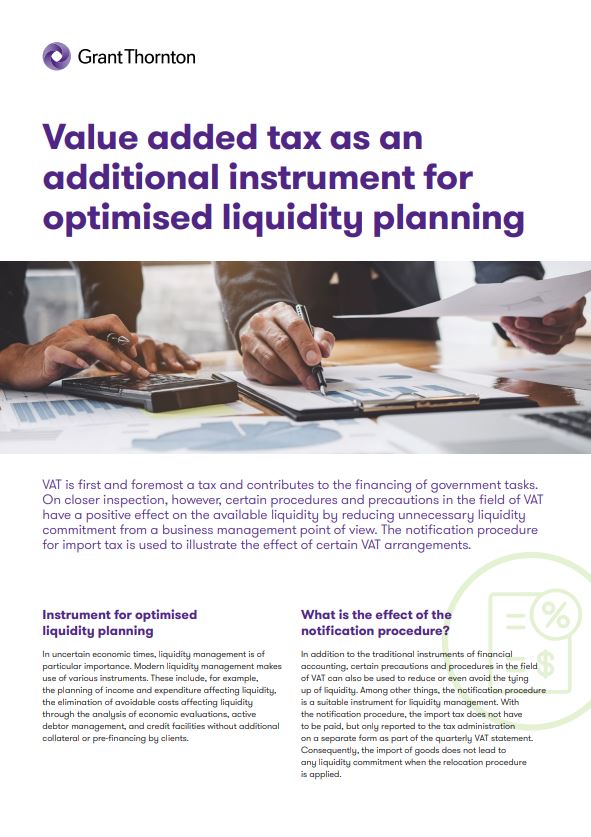-
Audit Industry, Services, Institutions
Mehr Sicherheit, mehr Vertrauen: Wirtschaftsprüfungen für nationale und internationale Geschäftskunden
-
Audit Financial Services
Mehr Sicherheit, mehr Vertrauen: Wirtschaftsprüfung für Banken und andere Finanzunternehmen
-
Corporate Tax
National and international tax consulting and planning
-
Individual Tax
Individual Tax
-
Indirect Tax/VAT
Our services in the area of value-added tax
-
Transfer Pricing
Our transfer pricing services.
-
M&A Tax
Advice throughout the transaction and deal cycle
-
Tax Financial Services
Our tax services for financial service providers.
-
Advisory IT & Digitalisation
Generating security with IT.
-
Forensic Services
Nowadays, the investigation of criminal offences in companies increasingly involves digital data and entire IT systems.
-
Regulatory & Compliance Financial Services
Advisory services in financial market law and sustainable finance.
-
Mergers & Acquisitions / Transaction Services
Successfully handling transactions with good advice.
-
Legal Services
Experts in commercial law.
-
Trust Services
We are there for you.
-
Business Risk Services
Sustainable growth for your company.
-
IFRS Services
Die Rechnungslegung nach den International Financial Reporting Standards (IFRS) und die Finanzberichterstattung stehen ständig vor neuen Herausforderungen durch Gesetzgeber, Regulierungsbehörden und Gremien. Einige IFRS-Rechnungslegungsthemen sind so komplex, dass sie generell schwer zu handhaben sind.
-
Abacus
Grant Thornton Switzerland Liechtenstein has been an official sales partner of Abacus Business Software since 2020.
-
Accounting Services
We keep accounts for you.
-
Payroll Services
Leave your payroll accounting to us.
-
Real Estate Management
Leave the management of your real estate to us.
-
Apprentices
Career with an apprenticeship?!

Instrument for optimised liquidity planning
In uncertain economic times, liquidity management is of particular importance. Modern liquidity management makes use of various instruments. These include, for example, the planning of income and expenditure affecting liquidity, the elimination of avoidable costs affecting liquidity through the analysis of economic evaluations, active debtor management, and credit facilities without additional collateral or pre-financing by clients.
What is the effect of the notification procedure?
In addition to the traditional instruments of financial accounting, certain precautions and procedures in the field of VAT can also be used to reduce or even avoid the tying up of liquidity. Among other things, the notification procedure is a suitable instrument for liquidity management. With the notification procedure, the import tax does not have to be paid, but only reported to the tax administration on a separate form as part of the quarterly VAT statement. Consequently, the import of goods does not lead to any liquidity commitment when the relocation procedure is applied.
What are the requirements of the notification procedure and for which companies is it suitable?
Access to the notification procedure has been gradually relaxed by the tax administration. However, an annual input tax credit of CHF 10,000 resulting from imports and exports remains a prerequisite. Companies that do not show such an annual input tax surplus are denied access to the relocation procedure.
A systematic input tax surplus is achieved, for example, by export-oriented companies that generate relatively little turnover domestically compared to their worldwide turnover and import raw materials or semi-finished goods as a result of having domestic production facilities. Art galleries can also generate systematic input tax surpluses if works of art are imported into the free movement of goods but sold predominantly to buyers domiciled or headquartered abroad and thus exempt from VAT. Depending on the business model, other types of businesses can also achieve systematic input tax surpluses. Last year, the tax administration paid out almost CHF 10 billion in input tax credits.
In addition to an annual input tax surplus of CHF 10,000, the application of the notification procedure requires in particular a detailed warehouse control. Furthermore, the company must account for the VAT according to the effective method. Moreover, the company may only use the imported goods for its own business activities and may not import goods on behalf of another company.
Example: notification procedure versus normal procedure
The following simplified example is intended to illustrate the liquidity effect of the relocation procedure compared to the normal VAT procedure.
Assuming that an item is imported into free domestic trade at the beginning of a calendar quarter (beginning of January) and the import tax is paid upon import, the company can deduct this as input tax in the quarterly statement for Q1. If the company submits the quarterly statement at the end of the 60-day period (end of May) and the tax administration pays the input tax credit within the newly defined 30-day period after receipt of the quarterly statement (end of June), approximately six months will have elapsed between payment of the import tax (to the customs administration) and refund of the input tax (by the tax administration).
If, on the other hand, the import takes place at the end of the calendar quarter (end of March) and the company submits the quarterly statement immediately after the end of the calendar quarter (beginning of April), it will take a good month until the tax administration refunds the tax after 30 days (beginning of May).
Based on this simplified example, it can be stated that without special precautions, liquidity remains tied up for between 1–6 months in the normal procedure compared to the notification procedure, or about 3.5 months on average. This example serves as an illustration and, in particular, does not take into account any other precautions that may also have the effect of shortening the period in which liquidity is trapped.
Grant Thornton Switzerland/Liechtenstein will be happy to support your company as a competent partner in evaluating possible precautions in the area of VAT to supplement your liquidity planning. Less liquidity tied up ultimately expands the entrepreneurial room for manoeuvre.

